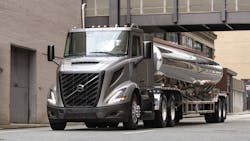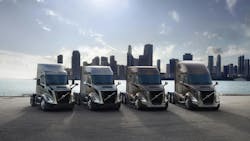Volvo Trucks unveiled its all-new VNR regional Class 8 truck, which is refreshed for the growing demands of bulk and flatbed haulers, during a special event at American Trucking Associations’ Technology & Maintenance Council exhibition.
With a tighter turning radius, the new VNR is built for shorter-range operations, the manufacturer said. It also features improved aerodynamics and can be spec’d in sleeper configurations for longer hauls. The new VNR shares a common platform with Volvo’s flagship VNL, which began serial production in 2024. “Both of the trucks have been built from essentially 90% new here in the U.S.,” Bobby Compton, VTNA product marketing manager for regional haul, said before VNR’s public debut.
New Volvo VNR tractor and truck configurations
The new Volvo VNR is available as a tractor or straight truck in daycab and sleeper configurations based on cab model, trim level, and more. Volvo Trucks North America is making the new Class 8 available in 4x2, 6x2, and 6x4 tractors and multiple straight truck body types.
VNR 300: Top choice for day cab regional haul and urban delivery operations. VTNA said the 300 model offers the best turning radius and maneuverability in the Class 8 market.
VNR 440: Compact, mid-roof 42-in. sleeper cab with high maneuverability and room to rest.
VNR 640: Mid-roof 62-in. sleeper designed for weight-sensitive bulk haul or flatbed deliveries.
VNR 660: A premium, more spacious 62-in. high-roof sleeper that can be used for regional or long-haul trips. VTNA said this model combines aerodynamics for highway efficiency with the tight turning radius of other VNR configurations. This model could help fleets working with more stringent length restrictions.
VNR straight truck: All VNR models—300, 440, 640, and 660—are available as customizable straight trucks for various applications, such as box vans, flatbeds, rollbacks, expeditors, or tankers.
Compton added that VTNA spent countless hours working with dealers, visiting truck stops, and digging into current regional customers’ operations to develop the new VNR. He also said Volvo Trucks implemented safety and efficiency technologies developed in Sweden, along with U.S. engineering improvements.
“We utilize the common platform and technologies and adapt and enhance it for the U.S. market,” said Johan Agebrand, VTNA product marketing director. “A lot from the VNL goes into the VNR, but the VNR has little differences.” Some of those differences include better visibility for surface roads and cities and shorter wheelbases. “We’ve taken everything we had on the VNL and tried to improve it a little bit for that regional haul segment,” he continued.
“That’s really what this truck is about.”
Along with updating the truck with technologies and amenities to benefit drivers who hop in and out of the VNR cab multiple times daily to complete deliveries, the new VNR focuses on regional wet and dry bulk carriers and flatbed operations.
“This truck is mostly catered to customers that would run 600 miles or less per day,” Agebrand said.
Compton said most VNR customers drive less than 600 miles daily, but some spend a night or two on the road. That's why the VNR is also available in three sleeper configurations, along with the VNR 300 daycab, which Volvo expects to be the top choice of return-to-base customers. The VNR is also available as a tractor or straight truck in compact, mid-, and high-roof sleeper configurations.
“A regional haul customer is so much more unique,” Compton said. “So we needed to tailor our truck to their needs. A long-haul driver typically doesn’t stop until they hit their eight-hour break. But a regional customer, in that first eight hours, will get in and out of that vehicle 10, 15 times. They will perform work between each time of getting in and out of the truck. So we had to give that rugged feel to the truck.”
Read more at FleetOwner.com, a Bulk Transporter affiliate.
About the Author

Josh Fisher
Technology Editor
FleetOwner Editor-in-Chief Josh Fisher has been with Endeavor's Commercial Vehicle Group since 2017, covering everything from modern fleet management to operational efficiency, artificial intelligence, autonomous trucking, regulations, and emerging transportation technology. He is based in Maryland.

